Urban Beetle Diversity in Natural History Collections—A Hundred-Year Perspective
Abstract
:1. Introduction
2. Materials and Methods
2.1. Study Area
2.2. Museum Specimens Revision
2.3. Data Analysis
3. Results
3.1. Faunistic Composition and Spatial Distribution
3.2. Chronology of the Records
3.3. Protected Species
3.4. Location Similarity
3.5. Change in Urban Areas over Time
4. Discussion
4.1. Benefits and Biases of Museum Collections and Citizen Science Data
4.2. Variation in Faunistic Composition
4.3. Change in Habitat
4.4. Potential Future Use of Museum Collections and Citizen Science Data
5. Conclusions
Supplementary Materials
Author Contributions
Funding
Institutional Review Board Statement
Data Availability Statement
Acknowledgments
Conflicts of Interest
References
- Bellard, C.; Bertelsmeier, C.; Leadley, P.; Thuiller, W.; Courchamp, F. Impacts of Climate Change on the Future of Biodiversity. Ecol. Lett. 2012, 15, 365–377. [Google Scholar] [CrossRef] [PubMed]
- Bradley, R.D.; Bradley, L.C.; Garner, H.J.; Baker, R.J. Assessing the Value of Natural History Collections and Addressing Issues Regarding Long-Term Growth and Care. Bioscience 2014, 64, 1150–1158. [Google Scholar] [CrossRef]
- Shultz, A.J.; Adams, B.J.; Bell, K.C.; Ludt, W.B.; Pauly, G.B.; Vendetti, J.E. Natural History Collections Are Critical Resources for Contemporary and Future Studies of Urban Evolution. Evol. Appl. 2021, 14, 233. [Google Scholar] [CrossRef] [PubMed]
- Mičetić Stanković, V.; Mihoci, I. Muzejska Obrada Zbirki (Vodenih) Kornjaša, s Posebnim Osvrtom Na Njihovo Trenutačno Stanje u Fundusu Hrvatskoga Prirodoslovnog Muzeja: Promišljanja i Smjernice. Inform. Museol. 2012, 43, 127–131. [Google Scholar]
- Löbl, I.; Klausnitzer, B.; Hartmann, M.; Krell, F.-T. The Silent Extinction of Species and Taxonomists—An Appeal to Science Policymakers and Legislators. Divers 2023, 15, 1053. [Google Scholar] [CrossRef]
- Holmes, M.W.; Hammond, T.T.; Wogan, G.O.U.; Walsh, R.E.; Labarbera, K.; Wommack, E.A.; Martins, F.M.; Crawford, J.C.; Mack, K.L.; Bloch, L.M.; et al. Natural History Collections as Windows on Evolutionary Processes. Mol. Ecol. 2016, 25, 864–881. [Google Scholar] [CrossRef]
- Ponder, W.F.; Carter, G.A.; Flemons, P.; Chapman, R.R. Evaluation of Museum Collection Data for Use in Biodiversity Assessment. Conserv. Biol. 2001, 15, 648–657. [Google Scholar] [CrossRef]
- Lister, A.M.; Brooks, S.J.; Fenberg, P.B.; Glover, A.G.; James, K.E.; Johnson, K.G.; Lister, A.M.; Michel, E.; Okamura, B.; Spencer, M.; et al. Natural History Collections as Sources of Long-Term Datasets. Trends Ecol. Evol. 2011, 26, 153–154. [Google Scholar] [CrossRef]
- McLean, B.S.; Bell, K.C.; Dunnum, J.L.; Abrahamson, B.; Colella, J.P.; Deardorff, E.R.; Weber, J.A.; Jones, A.K.; Salazar-Miralles, F.; Cook, J.A. Natural History Collections-Based Research: Progress, Promise, and Best Practices. J. Mammal. 2016, 97, 287–297. [Google Scholar] [CrossRef]
- Ward, D.F.; Leschen, R.A.B.; Buckley, T.R. More from Ecologists to Support Natural History Museums. Trends Ecol. Evol. 2015, 30, 373–374. [Google Scholar] [CrossRef]
- Kharouba, H.M.; Lewthwaite, J.M.M.; Guralnick, R.; Kerr, J.T.; Vellend, M. Using Insect Natural History Collections to Study Global Change Impacts: Challenges and Opportunities. Philos. Trans. R. Soc. Lond. B Biol. Sci. 2018, 374, 20170405. [Google Scholar] [CrossRef]
- MacPhail, V.J.; Richardson, L.L.; Colla, S.R. Incorporating Citizen Science, Museum Specimens, and Field Work into the Assessment of Extinction Risk of the American Bumble Bee (Bombus Pensylvanicus De Geer 1773) in Canada. J. Insect Conserv. 2019, 23, 597–611. [Google Scholar] [CrossRef]
- Meineke, E.K.; Davies, T.J. Museum Specimens Provide Novel Insights into Changing Plant-Herbivore Interactions. Philos. Trans. R. Soc. Lond. B Biol. Sci. 2018, 374, 20170393. [Google Scholar] [CrossRef]
- Wandeler, P.; Hoeck, P.E.A.; Keller, L.F. Back to the Future: Museum Specimens in Population Genetics. Trends Ecol. Evol. 2007, 22, 634–642. [Google Scholar] [CrossRef]
- Johnson, M.T.J.; Munshi-South, J. Evolution of Life in Urban Environments. Science 2017, 358, 6363. [Google Scholar] [CrossRef]
- McDonnell, M.J.; Hahs, A.K.; Breuste, J.H. Ecology of Cities and Towns: A Comparative Approach; Cambridge University Press: Oxford, UK, 2009. [Google Scholar]
- Lahr, E.C.; Dunn, R.R.; Frank, S.D. Getting Ahead of the Curve: Cities as Surrogates for Global Change. Proc. R. Soc. B Biol. Sci. 2018, 285, 20180643. [Google Scholar] [CrossRef]
- Alberti, M. Advances in Urban Ecology: Integrating Humans and Ecological Processes in Urban Ecosystems; Springer: New York, NY, USA, 2008; pp. 1–366. [Google Scholar] [CrossRef]
- Fattorini, S. Insect Extinction by Urbanization: A Long Term Study in Rome. Biol. Conserv. 2011, 144, 370–375. [Google Scholar] [CrossRef]
- Grimaldi, D.; Ginsberg, P.S.; Thayer, L.; McEvey, S.; Hauser, M.; Turelli, M.; Brown, B. Strange Little Flies in the Big City: Exotic Flower-Breeding Drosophilidae (Diptera) in Urban Los Angeles. PLoS ONE 2015, 10, e0122575. [Google Scholar] [CrossRef]
- Hartop, E.A.; Brown, B.V.; Disney, R.H.L. Opportunity in Our Ignorance: Urban Biodiversity Study Reveals 30 New Species and One New Nearctic Record for Megaselia (Diptera: Phoridae) in Los Angeles (California, USA). Zootaxa 2015, 3941, 451–484. [Google Scholar] [CrossRef]
- McIntyre, N.E.; Rango, J.; Fagan, W.F.; Faeth, S.H. Ground Arthropod Community Structure in a Heterogeneous Urban Environment. Landsc. Urban Plan. 2001, 52, 257–274. [Google Scholar] [CrossRef]
- Kotze, J.; Venn, S.; Niemelä, J.; Spence, J. Effects of Urbanization on the Ecology and Evolution of Arthropods. In Urban Ecology; Niemelä, J., Breuste, J.H., Elmqvist, T., Guntensper, G., James, P., McIntyre, N.E., Eds.; Oxford University Press: New York, USA, 2011; pp. 159–166. [Google Scholar]
- Bouchard, P.; Smith, A.B.T.; Douglas, H.; Gimmel, M.L.; Brunke, A.J.; Kanda, K. Biodiversity of Coleoptera: Science and Society. In Insect Biodiversity; Foottit, R.G., Adler, P.H., Eds.; Wiley: New York, USA, 2017; pp. 337–417. [Google Scholar]
- Zhang, Z.Q. Animal Biodiversity: An Introduction to Higher-Level Classification and Taxonomic Richness. Zootaxa 2011, 3148, 7–12. [Google Scholar] [CrossRef]
- New, T.R. Insect Conservation and Urban Environments; Springer: Cham, Switzerland, 2015; pp. 1–244. [Google Scholar]
- Speight, M.C.D. Saproxylic Invertebrates and Their Conservation; Nature and Environment Series, no. 42; Council of Europe: Strasbourg, France, 1989. [Google Scholar]
- Carpaneto, G.M.; Baviera, C.; Biscaccianti, A.; Brandmayr, P.; Mazzei, A.; Franco, M.; Battistoni, A.; Teofili, C.; Rondinini, C.; Fattorini, S.; et al. A Red List of Italian Saproxylic Beetles: Taxonomic Overview, Ecological Features and Conservation Issues (Coleoptera). Fragm. Entomol. 2015, 47, 53–126. [Google Scholar] [CrossRef]
- Lassauce, A.; Larrieu, L.; Paillet, Y.; Lieutier, F.; Bouget, C. The Effects of Forest Age on Saproxylic Beetle Biodiversity: Implications of Shortened and Extended Rotation Lengths in a French Oak High Forest. Insect Conserv. Divers. 2013, 6, 396–410. [Google Scholar] [CrossRef]
- Jonsell, M. Old Park Trees as Habitat for Saproxylic Beetle Species. Biodivers. Conserv. 2012, 21, 619–642. [Google Scholar] [CrossRef]
- Nieto, A.; Alexander, K.N.A. European Red List of Saproxylic Beetles; Publications Office of the European Union: Luxembourg, 2010. [Google Scholar]
- Konačni Rezultati Popis ’21; Croatian Bureau of Statistics: Zagreb, Croatia, 2022. (In Croatian)
- Kampuš, I.; Karaman, I. Tisućljetni Zagreb: Od Davnih Naselja Do Suvremenog Velegrada; Školska Knjiga: Zagreb, Croatia, 1988. (In Croatian) [Google Scholar]
- Goldstein, I.; Hutinec, G. Povijest Grada Zagreba: Knjiga 2: 20. i 21. Stoljeće; Novi Liber: Zagreb, Croatia, 2013. (In Croatian) [Google Scholar]
- Šerić Jelaska, L.; Ješovnik, A.; Jelaska, S.D.; Pirnat, A.; Kučinić, M.; Durbešić, P. Variations of Carabid Beetle and Ant Assemblages, and Their Morpho-Ecological Traits within Natural Temperate Forests in Medvednica Nature Park. Šumarski List 2010, 134, 475–486. [Google Scholar]
- Dražina, T.; Temunović, M.; Šerić Jelaska, L. Saproksilna Zajednica Kornjaša Starih Gradskih Parkova: Primjer Iz Parka Maksimir (Zagreb, Hrvatska). In Proceedings of the 11th Croatian Biological Congress, Šibenik, Croatia, 15–18 September 2022; Jelaska, S.D., Klobučar, G., Šerić Jelaska, L., Leljak Levanić, D., Lukša, Ž., Eds.; Croatian Biological Society: Šibenik, Croatia, 2012; pp. 78–79. [Google Scholar]
- Spear, D.M.; Pauly, G.B.; Kaiser, K. Citizen Science as a Tool for Augmenting Museum Collection Data from Urban Areas. Front. Ecol. Evol. 2017, 5, 275460. [Google Scholar] [CrossRef]
- Balabanić, J.; Tvrtković, N.; Vuković, M. Natura + Cultura: Muzejski Prirodoslovni Predmet—Pokretno Kulturno Dobro; Croatian Natural History Museum—Museum Exhibition: Zagreb, Croatia, 1996; p. 61. (In Croatian) [Google Scholar]
- Šegota, T.; Filipčić, A.; Članak, S.; Zagreb, P.; Odsjek, G. Köppen’s Classification of Climates and the Problem of Corresponding Croatian Terminology. Geoadria 2003, 8, 17–37. [Google Scholar] [CrossRef]
- Šiško, D.; Polančec, V. Zagreb u Brojkama; Gradski ured za strategijsko planiranje i razvoj Grada, Sektor za strategijske informacije i istraživanja, Odjel za statističke i analitičke Poslove: Zagreb, Croatia, 2020. (In Croatian) [Google Scholar]
- Šikić, K.; Basch, O.; Šimunić, A. Osnovna Geološka Karta SFRJ 1:100.000, Tumač Za List Zagreb L33–80; Savezni Geološki Zavod: Beograd, Yugoslavia, 1979. (In Croatian) [Google Scholar]
- Britvec, B. Prof. Antun Korlević—Prvi Hrvatski Visokoškolski Nastavnik Entomologije—Povodom 150. Obljetnice Rođenja. Entomol. Croat. 2001, 5, 77–84. (In Croatian) [Google Scholar]
- Božičević, S. Vladimir Redenšek—Prirodoslovac i Speleolog. Priroda 1972, 10, 315–316. (In Croatian) [Google Scholar]
- Löbl, I.; Smetana, A. Catalogue of Palaearctic Coleoptera Vol. 1; Apollo Books: Stenstrup, Denmark, 2003. [Google Scholar]
- Löbl, I.; Smetana, A. Catalogue of Palaearctic Coleoptera Vol. 2; Apollo Books: Stenstrup, Denmark, 2004. [Google Scholar]
- Löbl, I.; Smetana, A. Catalogue of Palaearctic Coleoptera Vol. 3; Apollo Books: Stenstrup, Denmark, 2006. [Google Scholar]
- Löbl, I.; Smetana, A. Catalogue of Palaearctic Coleoptera Vol. 4; Apollo Books: Stenstrup, Denmark, 2007. [Google Scholar]
- Löbl, I.; Smetana, A. Catalogue of Palaearctic Coleoptera Vol. 5; Apollo Books: Stenstrup, Denmark, 2008. [Google Scholar]
- Löbl, I.; Smetana, A. Catalogue of Palaearctic Coleoptera Vol. 6; Apollo Books: Stenstrup, Denmark, 2010. [Google Scholar]
- Alonso-Zarazaga, M.A.; Barrios, H.; Borovec, R.; Bouchard, P.; Caldara, R.; Colonnelli, E.; Gültekin, L.; Hlaváþ, P.; Korotyaev, B.; Lyal, C.H.C.; et al. Cooperative Catalogue of Palaearctic Coleoptera Curculionoidea. Monogr. Electrónicas SEA 2017, 8, 1–729. [Google Scholar]
- Global Biodiversity Information Facility. Available online: https://www.gbif.org (accessed on 20 October 2023).
- Fauna Europaea. Available online: https://fauna-eu.org (accessed on 1 February 2021).
- Digitalne Zbirke Nacionalne i Sveučilišne Knjižnice u Zagrebu. Available online: https://digitalna.nsk.hr (accessed on 10 October 2023). (In Croatian).
- Global Biodiversity Information Facility. Available online: https://doi.org/10.15468/Dl.8jgz4f (accessed on 20 October 2023).
- Clarke, K.R.; Warwick, R.M. Change in Marine Communities: An Approach to Statistical Analysis and Interpretation; Primer-E Ltd.: Plymouth, UK, 2014. [Google Scholar]
- Clarke, K.R.; Gorley, R.N. Primer User Manual/Tutorial V7; PRIMER-e: Auckland, New Zealand, 2015. [Google Scholar]
- Portal GeoHub Zagreb. Available online: https://geohub-Zagreb.hub.arcgis.com (accessed on 5 October 2023).
- The IUCN Red List of Threatened Species. Available online: https://www.iucnredlist.org (accessed on 10 October 2023).
- Meineke, E.K.; Davies, T.J.; Daru, B.H.; Davis, C.C. Biological Collections for Understanding Biodiversity in the Anthropocene. Philos. Trans. R. Soc. B 2019, 374, 20170386. [Google Scholar] [CrossRef]
- Zapponi, L.; Cini, A.; Bardiani, M.; Hardersen, S.; Maura, M.; Maurizi, E.; Redolfi De Zan, L.; Audisio, P.; Bologna, M.A.; Carpaneto, G.M.; et al. Citizen Science Data as an Efficient Tool for Mapping Protected Saproxylic Beetles. Biol. Conserv. 2017, 208, 139–145. [Google Scholar] [CrossRef]
- Hiller, T.; Haelewaters, D. A Case of Silent Invasion: Citizen Science Confirms the Presence of Harmonia Axyridis (Coleoptera, Coccinellidae) in Central America. PLoS ONE 2019, 14, e0220082. [Google Scholar] [CrossRef]
- Walsh, G.B.; Dibb, J.R. A Coleopterologist’s Handbook; Amateur Entomologists Society: London, UK, 1954. [Google Scholar]
- Marjanac, S. Vladimir Redenšek. Speleolog 1972, 20–21, 14. (In Croatian) [Google Scholar]
- Santangelo, J.S.; Ruth Rivkin, L.; Johnson, M.T.J. The Evolution of City Life. Proc. R. Soc. B 2018, 285, 20181529. [Google Scholar] [CrossRef]
- Kotze, D.J.; Brandmayr, P.; Casale, A.; Dauffy-Richard, E.; Dekoninck, W.; Koivula, M.J.; Lövei, G.L.; Mossakowski, D.; Noordijk, J.; Paarmann, W.; et al. Forty Years of Carabid Beetle Research in Europe—From Taxonomy, Biology, Ecology and Population Studies to Bioindication, Habitat Assessment and Conservation. Zookeys 2011, 100, 55. [Google Scholar] [CrossRef]
- McGregor, R.; Wahl, V. Beetles in the City: Ground Beetles (Coleoptera: Carabidae) in Coquitlam, British Columbia as Indicators of Human Disturbance. J. Entomol. Soc. Br. Columbia 2021, 117, 20–30. [Google Scholar]
- Kędzior, R.; Szwalec, A.; Mundała, P.; Skalski, T. Ground Beetle (Coleoptera, Carabidae) Life History Traits as Indicators of Habitat Recovering Processes in Postindustrial Areas. Ecol. Eng. 2020, 142, 105615. [Google Scholar] [CrossRef]
- Vujević, D.; Čalopek, M.; Novosel, M.; Anić-Vučinić, A. Composition of Landfill Gas on Prudinec/Jakuševec Landfill. Environ. Eng. 2014, 1, 33–41. [Google Scholar]
- Crowson, R.A. The Biology of the Coleoptera, 1st ed.; Academic Press: London, UK, 1981. [Google Scholar]
- Jaskuła, R.; Kolanowska, M.; Michalski, M.; Schwerk, A. From Phenology and Habitat Preferences to Climate Change: Importance of Citizen Science in Studying Insect Ecology in the Continental Scale with American Red Flat Bark Beetle, Cucujus Clavipes, as a Model Species. Insects 2021, 12, 369. [Google Scholar] [CrossRef]
- Braz Sousa, L.; Fricker, S.R.; Doherty, S.S.; Webb, C.E.; Baldock, K.L.; Williams, C.R. Citizen Science and Smartphone E-Entomology Enables Low-Cost Upscaling of Mosquito Surveillance. Sci. Total Environ. 2020, 704, 135349. [Google Scholar] [CrossRef] [PubMed]
- Garretson, A.; Cuddy, T.; Duffy, A.G.; Forkner, R.E. Citizen Science Data Reveal Regional Heterogeneity in Phenological Response to Climate in the Large Milkweed Bug, Oncopeltus Fasciatus. Ecol. Evol. 2023, 13, e10213. [Google Scholar] [CrossRef] [PubMed]
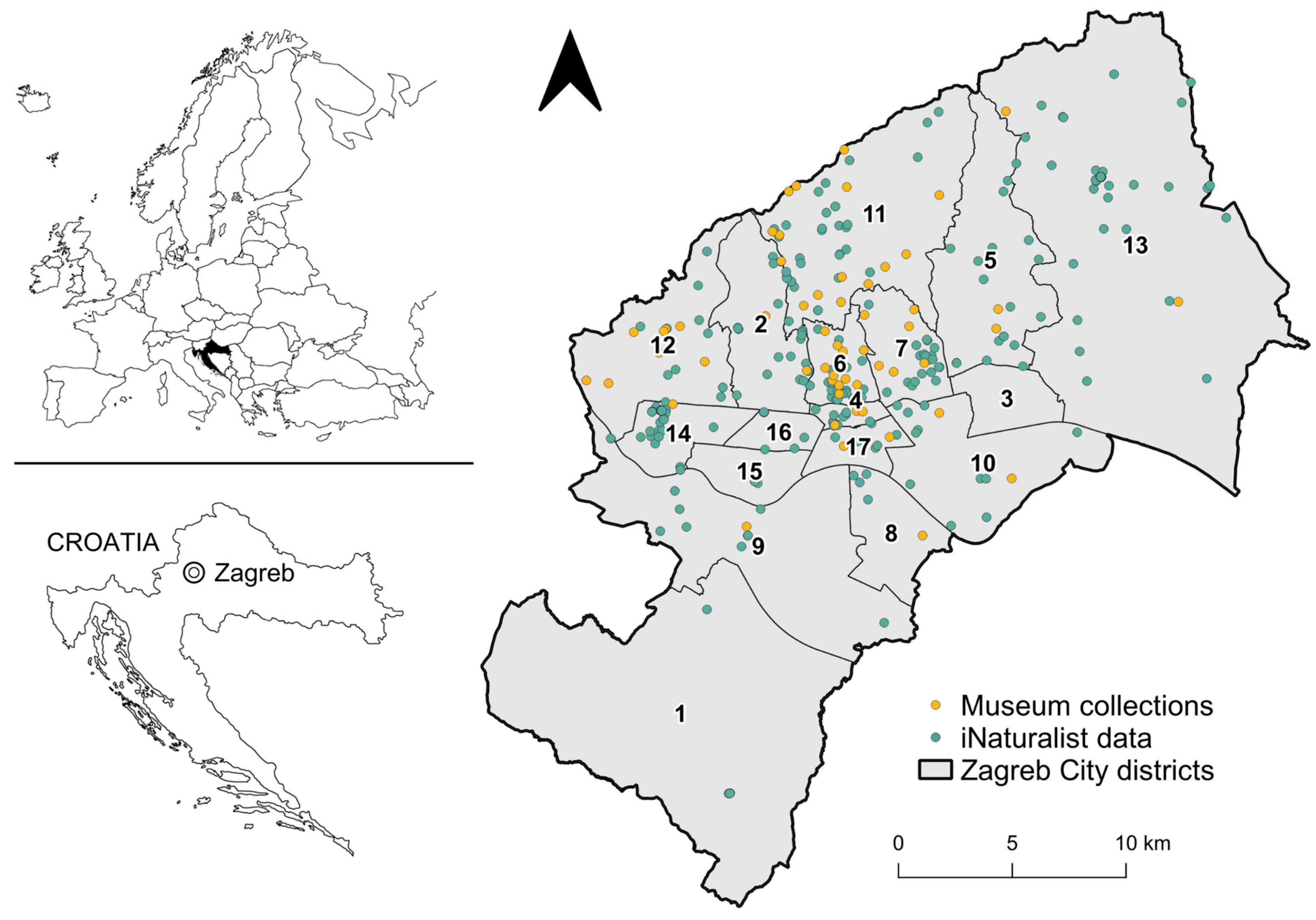
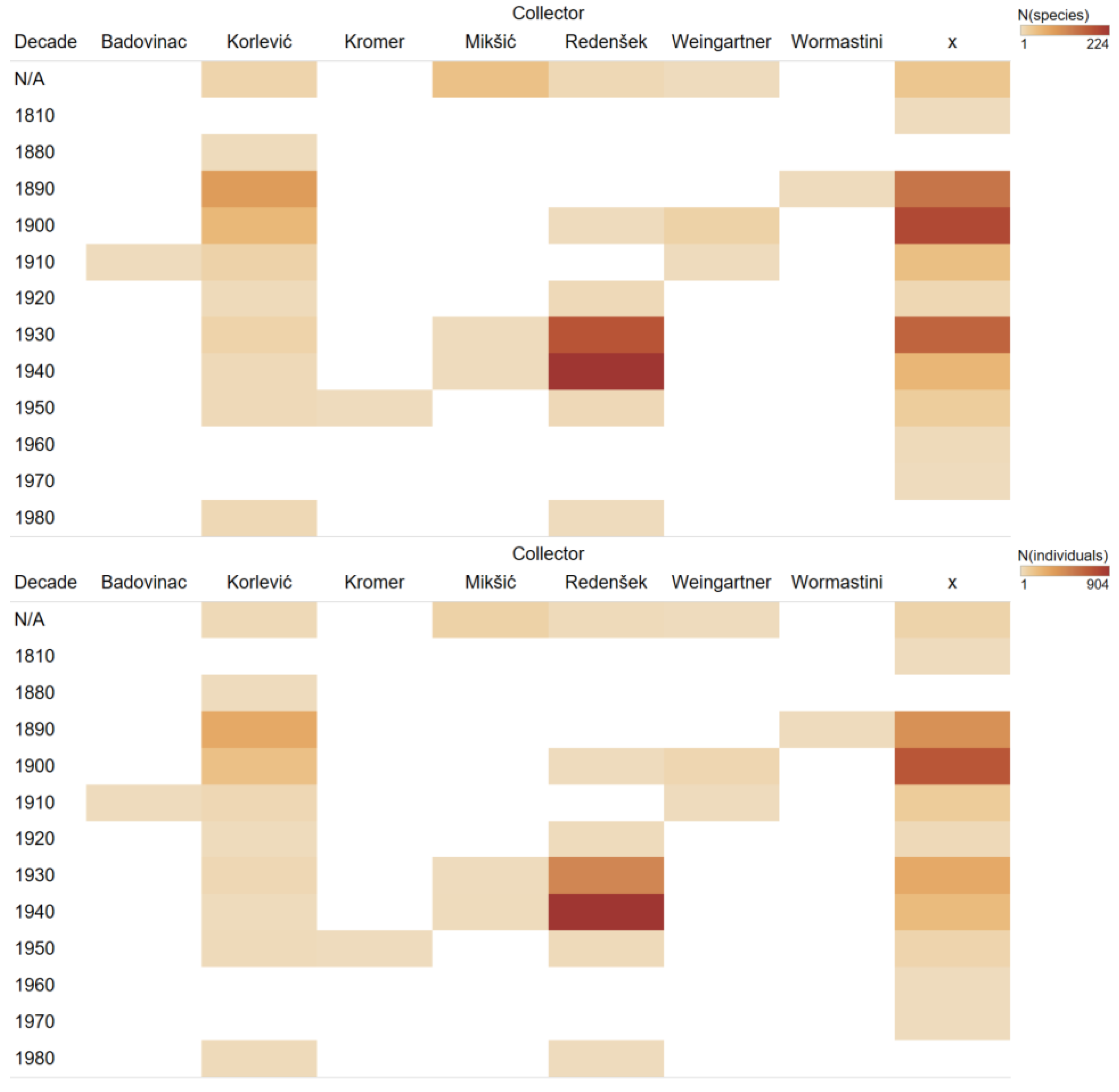

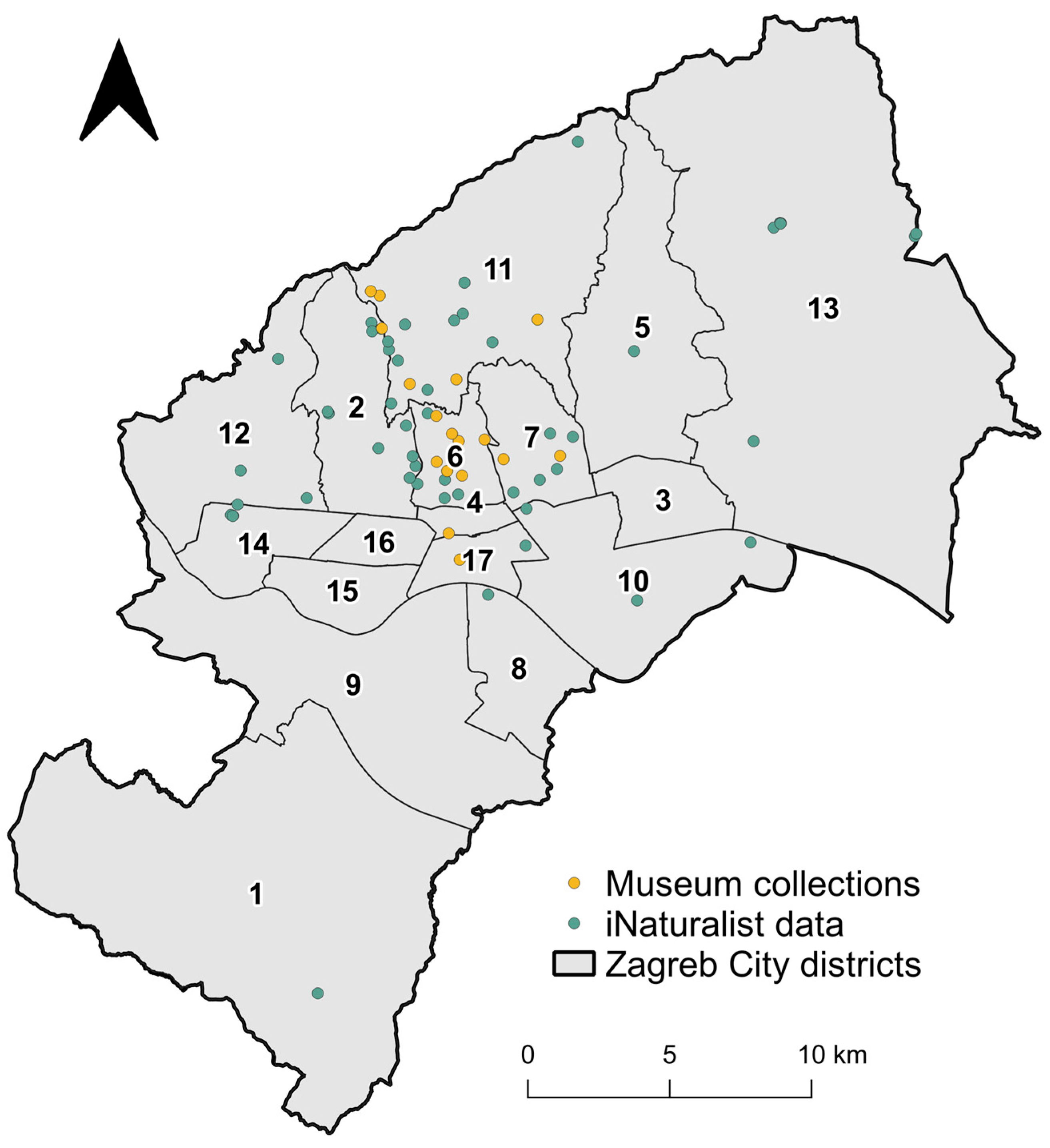

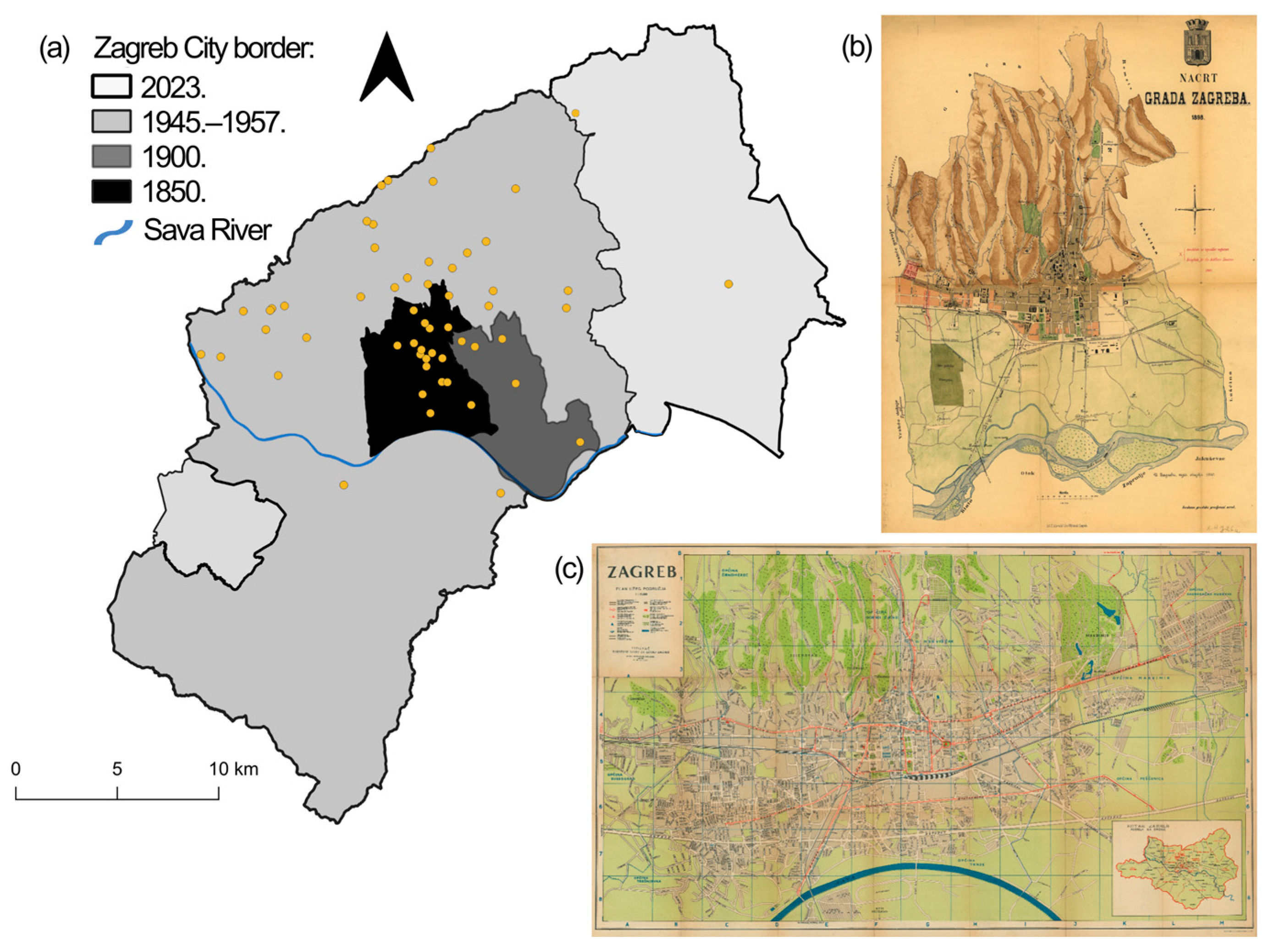
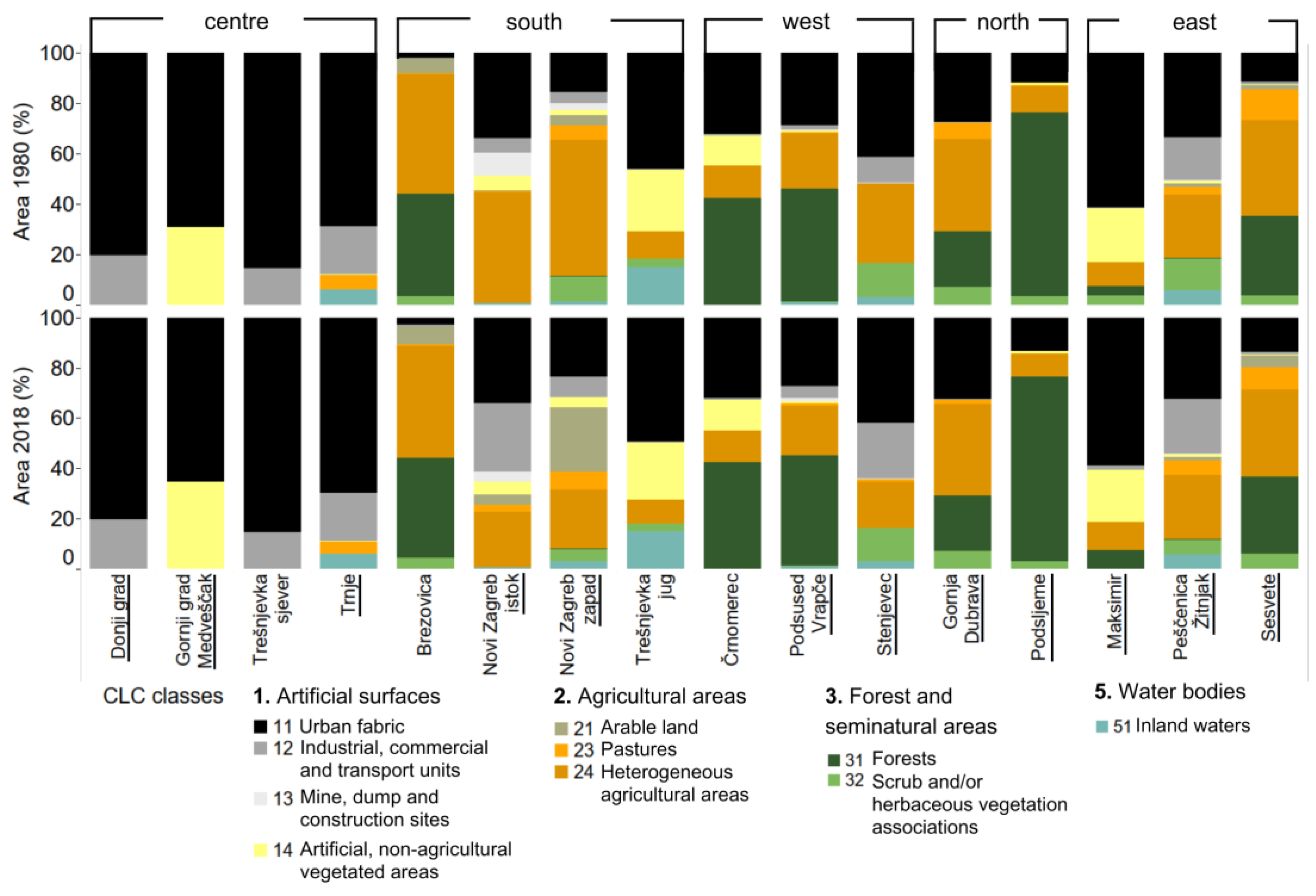
Disclaimer/Publisher’s Note: The statements, opinions and data contained in all publications are solely those of the individual author(s) and contributor(s) and not of MDPI and/or the editor(s). MDPI and/or the editor(s) disclaim responsibility for any injury to people or property resulting from any ideas, methods, instructions or products referred to in the content. |
© 2023 by the authors. Licensee MDPI, Basel, Switzerland. This article is an open access article distributed under the terms and conditions of the Creative Commons Attribution (CC BY) license (https://creativecommons.org/licenses/by/4.0/).
Share and Cite
Ružanović, L.; Mičetić Stanković, V. Urban Beetle Diversity in Natural History Collections—A Hundred-Year Perspective. Diversity 2023, 15, 1224. https://doi.org/10.3390/d15121224
Ružanović L, Mičetić Stanković V. Urban Beetle Diversity in Natural History Collections—A Hundred-Year Perspective. Diversity. 2023; 15(12):1224. https://doi.org/10.3390/d15121224
Chicago/Turabian StyleRužanović, Lea, and Vlatka Mičetić Stanković. 2023. "Urban Beetle Diversity in Natural History Collections—A Hundred-Year Perspective" Diversity 15, no. 12: 1224. https://doi.org/10.3390/d15121224
APA StyleRužanović, L., & Mičetić Stanković, V. (2023). Urban Beetle Diversity in Natural History Collections—A Hundred-Year Perspective. Diversity, 15(12), 1224. https://doi.org/10.3390/d15121224






